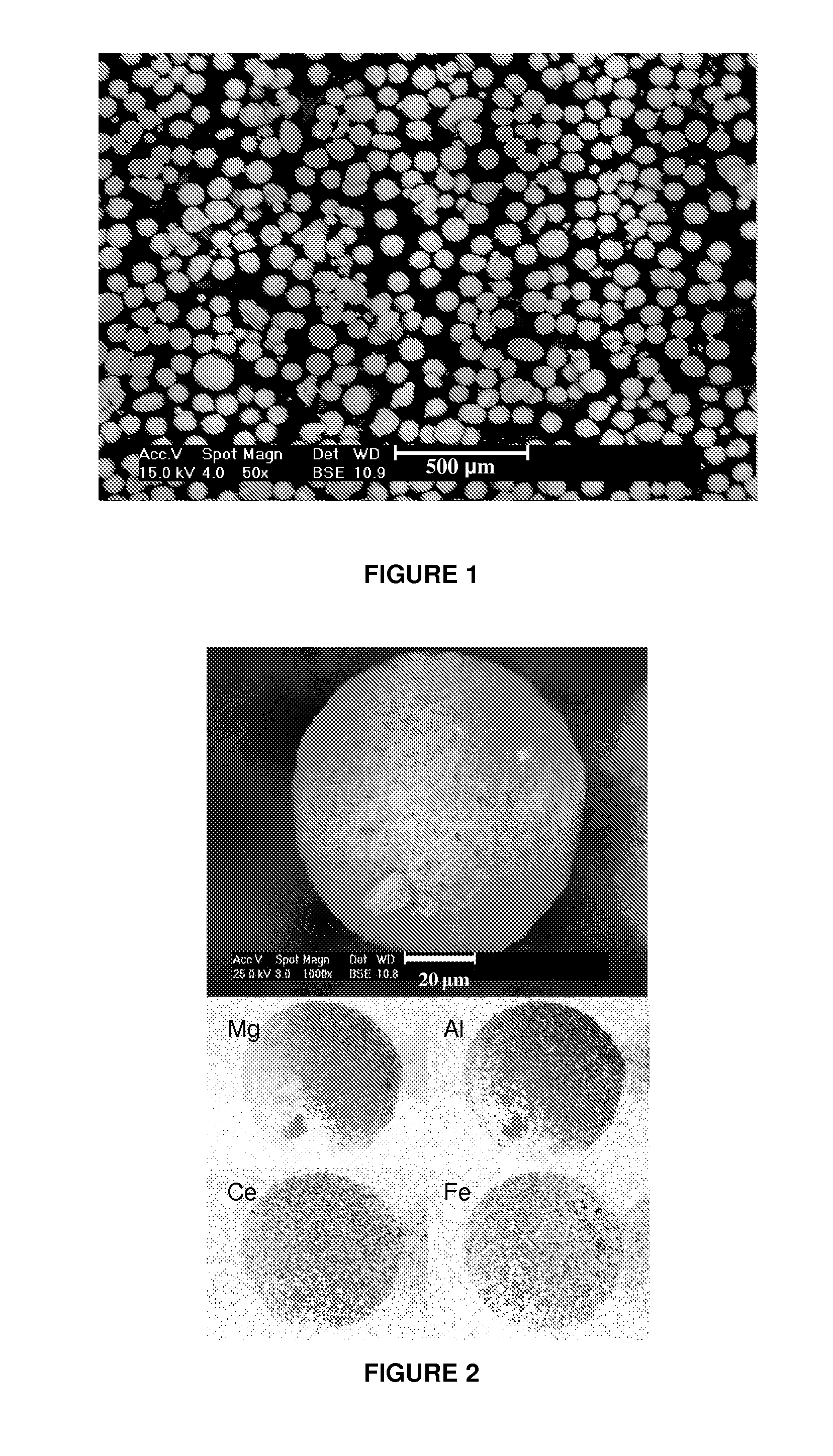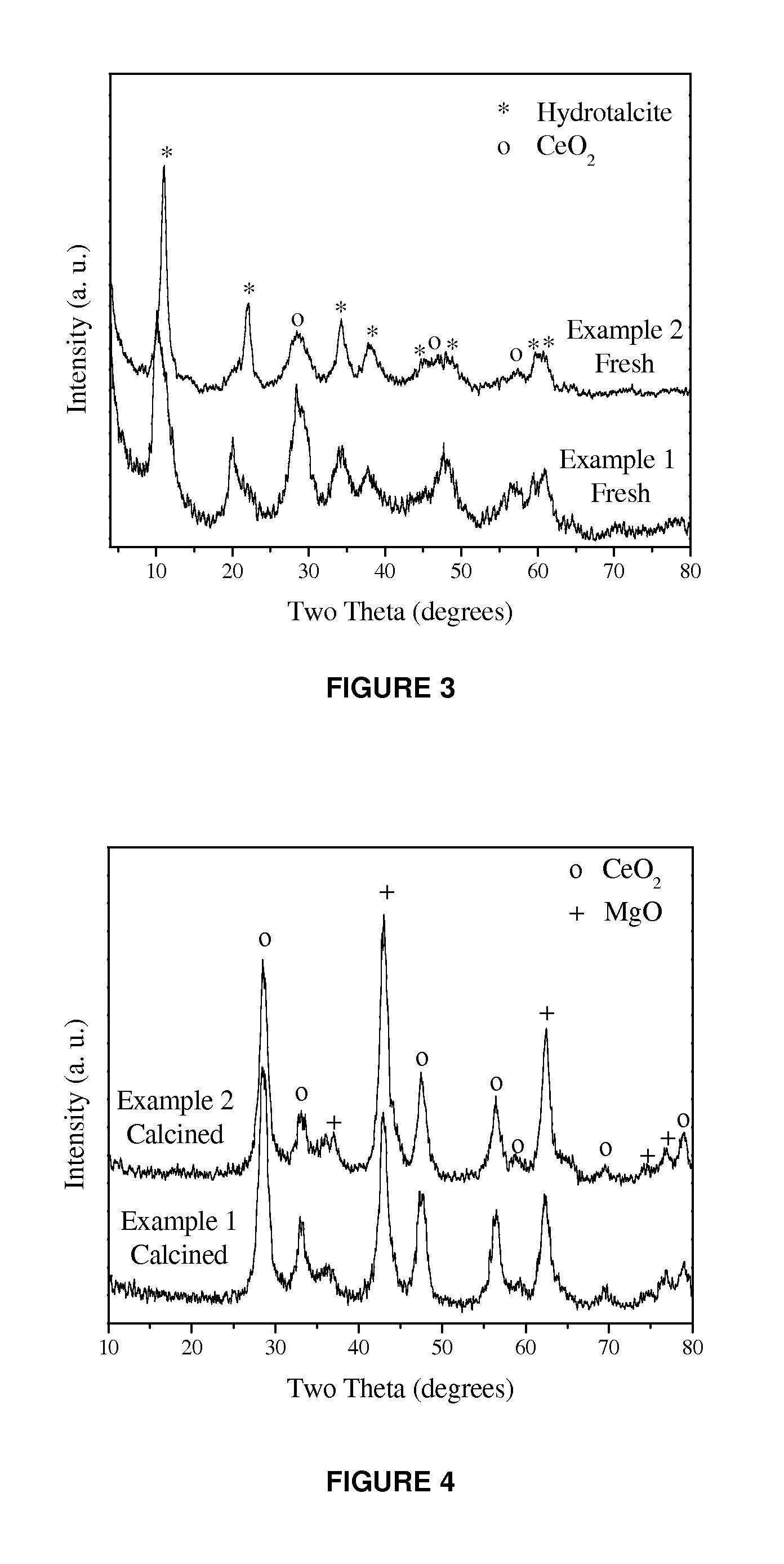Multimetallic anionic clays and derived products for SOx removal in the fluid catalytic cracking process
a technology of multimetallic anionic clay and sox removal, applied in the direction of catalytic cracking, hydrocarbon oil treatment, metal/metal-oxide/metal-hydroxide catalyst, etc., can solve the problem of reducing the capacity of additives for sox removal, forming carbonaceous side-products denoted as coke, and exhibiting negative environmental effects. , to achieve the effect of improving the capacity of reducing sulfur oxides, improving the efficiency and versatility o
- Summary
- Abstract
- Description
- Claims
- Application Information
AI Technical Summary
Benefits of technology
Problems solved by technology
Method used
Image
Examples
example 1
[0099]This example describes preparation and shaping of a MAC to be used as additive for reducing SOx emissions in conditions of oxygen deficiency related to the operation in partial combustion mode of the regenerator of fluid catalytic cracking units. 62.2 g of acetic acid (85 wt % purity) are dissolved in 1.92 L of H2O. Then, 376.84 g of MgO are added and the mixture is stirred at 500 rpm for 1 h (A). 364.33 g of Fe(NO3)3.9H2O as well as 377.69 g of cerium nitrate solution (22.77 wt % Ce) are dissolved separately in 4.83 L of water Once the iron nitrate has dissolved, 154.69 g of HiQ-31 boehmite are added and the resulting mixture is stirred at 500 rpm for 1 h (B). The gel product (B) is mixed with the product (A). Temperature is maintained at 100° C. and the mixture is stirred at 500 rpm while it is passed through an in-line high shear mixer for 3 h. The produced slurry is then spray dried with hot air at 400° C. and a feed pressure of 120 psi in order to evaporate the aqueous ph...
example 2
[0103]This example discloses preparation and shaping of a MAC adjusting its composition to control SOx emissions in conditions of oxygen excess in relation to the operation of the regenerator of fluid catalytic cracking units, i.e., full combustion mode. 62.2 g of acetic acid (85%) are dissolved in 1.92 L of H2O. Then 383.24 g of MgO are added and stirred at 500 rpm for 1 h (A). 182.16 g of Fe(NO3)3.9H2O together with 219.58 g of cerium nitrate solution (22.77% Ce) are dissolved separately in 4.8 l of water. Once the iron nitrate is dissolved, 197.61 g of HiQ-31 boehmite are added and the mixture is stirred at 500 rpm for 1 h (B). The gel product (B) is mixed with the product (A). Temperature is maintained at 100° C. and the mixture is stirred at 500 rpm while it is passed through an in-line high shear mixer for 3 h. The slurry is subsequently spray dried with hot air at 400° C. and a feed pressure of 120 psi. The spray dried microspheres are calcined at 732° C. for 4 h.
[0104]FIG. 1...
example 3
[0105]This example shows the effectiveness of the additive produced according to Example 1 for reducing SOx emissions generated in a pilot scale activity test. A distinctive, particular aspect of the test of this example is that the pilot unit regenerator was operated with an oxygen deficiency with respect to the amount required by stoichiometry to burn the coke that deposits on the catalyst, i.e. partial combustion mode. In order to perform the test under realistic conditions, an industrial gas oil containing about 2 wt % sulfur was used as feed while the pilot unit was loaded with an equilibrium catalyst Ecat composed by REUSY zeolite. The properties of the gas oil are displayed in Table 4 whereas those of the Ecat are presented in Table 5. The values of the key operating conditions were the following: feed preheating temperature of 170° C., gas oil inlet flow rate of 1.2 kg / h, catalyst to oil ratio of 10, reaction temperature of 520° C., dense bed regenerator temperature of 690° ...
PUM
| Property | Measurement | Unit |
|---|---|---|
| diameter | aaaaa | aaaaa |
| diameter | aaaaa | aaaaa |
| mass ratio | aaaaa | aaaaa |
Abstract
Description
Claims
Application Information
 Login to View More
Login to View More - R&D
- Intellectual Property
- Life Sciences
- Materials
- Tech Scout
- Unparalleled Data Quality
- Higher Quality Content
- 60% Fewer Hallucinations
Browse by: Latest US Patents, China's latest patents, Technical Efficacy Thesaurus, Application Domain, Technology Topic, Popular Technical Reports.
© 2025 PatSnap. All rights reserved.Legal|Privacy policy|Modern Slavery Act Transparency Statement|Sitemap|About US| Contact US: help@patsnap.com



